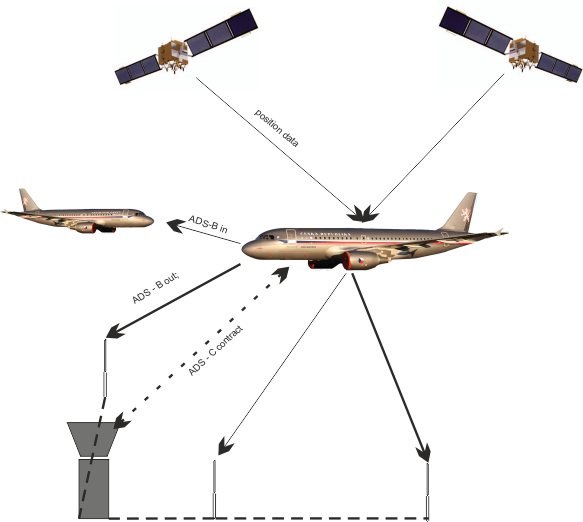ADS-B
At present, most surveillance systems monitoring air space are based on the secondary radar (SSR) principle when the ground radar transmits interrogations pulses at a frequency of 1030 MHz, and the plane responds at 1090 MHz. In response are encoded data about the altitude and identification code (the so-called "alpha") and, depending on the type of transponder, additional information about the aircraft.
Secondary radar was and still is a very useful method for obtaining an overview of traffic in the airspace, but with the increase of an air traffic this method becomes obsolete, especially in the concepts of future air traffic controlling. The future should be in the SESAR (EU) and NextGen (USA) programs which emphasize on greater efficiency, minimizing infrastructure costs, increasing safety, increasing accuracy of surveillance, but also require more precise on-board aircraft and ground equipment. One such system that meets the above requirements is ADS-B.
ADS - division
Automatic Dependent System – je systém pro přehled o vzdušné situaci založený na principu předávání dat a polohy z letadla na pozemní přijímače pomocí standardních komunikačních linek (1090 MHz, VDL, atd.), a dále také ostatním letadlům ve vzdušném prostoru.
ADS rozdělujeme na:

ADS-A and ADS-C
Both abbreviations are practically the same designation of one principle - ADS based on the principle of establishing addressed communication link between the aircraft and the air traffic control unit. According to Internet sources, ADS-C is sending position data from GNSS via ACARS network and ADS-A is sending “unspecified position data” via an “agreed datalink”. ADS-A/C are used for ocean-based applications when the aircraft sends automatically the position data to the ground after a certain period of time. Location information can be sent:
- Periodiccally
- On request from ATC
- At certain events – flight over specific navigation point, altitude change, deviation from the track
Otherwise, it uses the same devices and principles as ADS-B.
ADS-B OUT
ADS-B out - Position data obtained from GNSS, identification data, velocity and altitude are periodically transmitted by airplane to the ADS-B terrestrial network and processed in a form suitable for ATM. Due to the use of GNSS location data are more accurate than from "classic secondary radar".
ADS-B IN
Data are not send to the terrestrial network but are distributed to all nearby airplanes. Data send from ADS-B out, ATSAW (Airborne Traffic Situation Awareness), data on vertical and horizontal separation, weather, NOTAMs, etc. can be send via this datalink. The best known usage is in TCAS.
ADS-B, function principle with S mode
Classical secondary radars that identify aircraft through SSRs interrogation are gradually replaced by radars that support mode S interrogation. Mode S is used to identify the unique address of the transponder onboard plane and allows sending additional data beyond the basic identification data. In the response data block is space called "extended" for the supplemental data, which uses ADS-B for GNSS position data. More about Mode S is available on
radartutorial.eu websites.
The following data is encoded in the Mode S response:
- Position
- Barometric altitude
- Quality indication
Identification of an airplane:
- Unique 24 bit address of an airplane
- Identification data
- Mode code A
- Emergency status
- SPI (special position indicator)
TCAS and ADS-B IN
TCAS (Traffic alert and collision avoidance system) je protisrážkový systém, který spadá pod myšlenku ACAS (airborne collision avoidance system), který může využít i informace vysílané přes ADS-B, aby zvýšil svou efektivitu. Tato metoda se nazývá
"hybrid surveillance" (hybridní informace o přehledové situaci) a snižuje četnost dotazů systému TCAS, což má za následek snížení zatížení frekvence 1030/1090 MHz. ADS-B jako takové
neplní přímo funkci TCAS, není schopné předávat posádce příkazy, ale slouží pouze pro zvýšení efektivity TCAS, případně dokáže zobrazit jiná letadla na vlastním mapovém podkladu. ADS-B pak vysílá každou sekundu informace o poloze.
